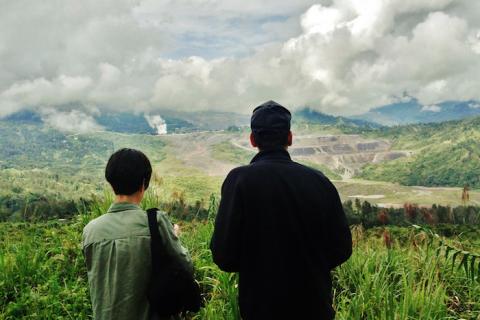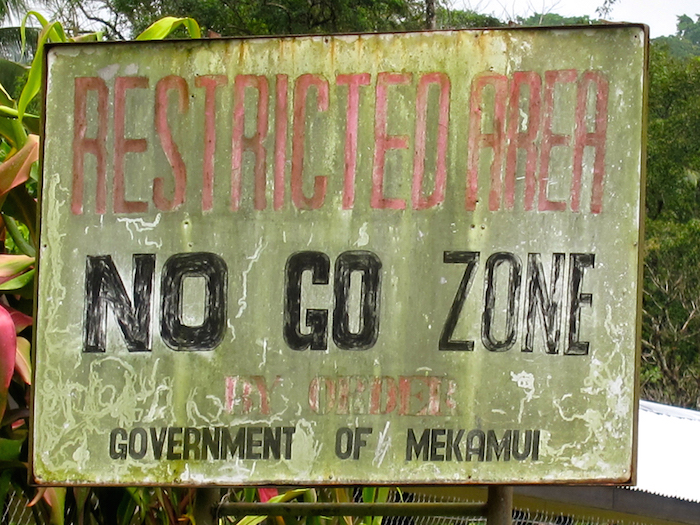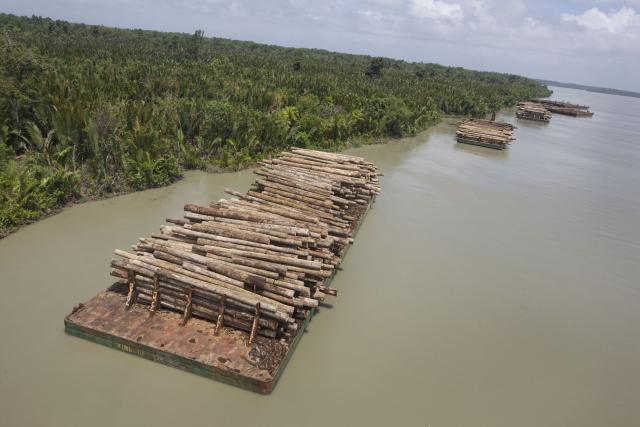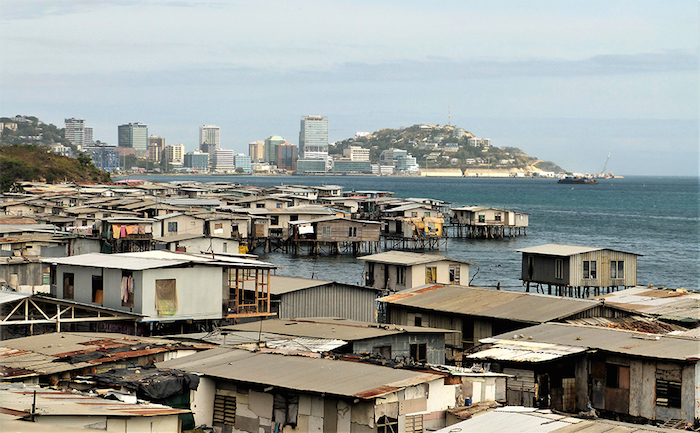By Anne Hennings, reviewed by Rosa Koian, editor of Wantok Niuspepa newspaper
7 May 2021
Papua New Guinea gained independence from Australia in 1975 and is one of the ethnically most diverse countries worldwide. More than 87% of the rural populations live off farming, and agriculture contributes about 28% to the national GDP1. Furthermore, the country generates revenues from the large-scale export of mineral resources, oil, gas, and timber.

85% of the country’s land is under customary tenure
Photo: Penn State, 2015. Gold mine in Papua New Guinea. CC BY-NC-ND 2.0 license
Papua New Guinea has one of the most unique tenure systems in the world with 85% of the country’s land under customary tenure. Communities are culturally and spiritually closely connected to their land. However, the government aims to formalize 20 % of the land by 2022 to further “unlock” the economic value of the country and attract investments in palm oil, mining, and timber operations2. In this light, the Prime Minister announced in 2019 to create up to 18 new special economic zones.
Over the past decades, large-scale extractive operations have largely led to environmental damages and the loss of livelihoods, and caused multiple - often violent - land disputes within and between communities3. The most prominent conflict arose over the Panguna copper mine in the Autonomous Region of Bougainville. The lack of transparency in the agreements, human rights violations, and community-company as well as intergenerational conflicts over benefit-sharing resulted in what is often referred to as the world’s first “eco-war” (1988 to 1998)4. All these factors still play a role in most land acquisitions particularly under the Special Agricultural Business Leases (SABL) scheme today. The question of how to translate Papua New Guinea’s resource wealth into inclusive, equitable and sustainable development has remained largely disregarded.
Land legislation and regulations
The Land Act governs the administration of all land including customary land which is controlled by different clans5. Customary tenure practices vary from community to community and are usually passed on orally by village elders or chiefs. Under British, German, and Australian colonial rule, large tracts of customary land were allocated to foreigners for agribusiness or mining purposes. In order to prevent history from repeating itself, the post-independence government enshrined the protection of customary rights in the constitution and later in the Land Act6. In addition, the Plantation Redistribution Scheme that was adopted in the advent of independence in 1974 aimed to retrieve freehold land that was expropriated by foreigners under colonial rule. The National Land Development Plan (2011-2030) is the most recent amendment to the Land Act7. The plan’s first phase put emphasis on supporting the Provincial Land Dispute Committees.
The Department of Land and Physical Planning with its sub-divisions is the main government authority responsible for land matters. These include the Office of the Registrar of Titles, the Incorporated Land Group (ILG) Division, which is responsible for registering ILGs, the Customary Land Registration Division, that registers customary land and SABLs, and the Development Planning Division, which manages rural and urban infrastructure development.
Land tenure classifications
There are two categories of land in Papua New Guinea: customary and alienated land. From independence up until recently, the amount of actually held customary land has dropped from 97% to about 85%, notably since the introduction of the SABL scheme8. Specific rules and practices of customary ownership and the provision of usufructuary rights, in terms of duration or community and individuals rights, vary between groups across the country9.
Alienated land includes State land as well as freehold land10. State land was previously (compulsory) acquired from customary owners and is used for government infrastructure, such as courts, health or education facilities. Freehold land can be used for agricultural purposes as well as churches and may be transferred or leased11. Customary land can be converted into freehold land following an application through the Land Titles Commissioner12. Whereas customary is not required to be registered, freehold land and State land are evidenced by title certificates13.
Land disputes
Land disputes between and within clans especially in the highlands have always occurred frequently. Yet, they have intensified in areas of agribusiness and mining operations with large numbers of migrant laborers and settlers, leading to internal displacement and urbanization14. Conflict resolution is regulated by the Land Dispute Settlement Act that largely draws on traditional mediation approaches15. In addition to the Provincial Land Dispute Committees, there are approximately 1,200 state-sanctioned and numerous informal land mediators. If a mediation is not successful, the Local or Provincial Land Court takes over. Protracted cases concerning the national interest, such as disputes evolving around resource extraction, are handled by the Land Titles Commissioner16.

Mekamui/Panguna, by madlemurs, 2011, CC BY-NC 2.0 license
Land use trends
Papua New Guinea is a resource rich country with 87% of the population living in rural areas17. Livelihoods center around shifting cultivation, forestry, and fishing. Farming includes staple food crops such as potatoes, sweet potatoes, bananas but also coffee, cocoa, copra, and vanilla18. About one quarter of the land area is arable land of which 7% are classified as high-quality land suitable for large-scale agricultural projects. The government announced to increase the amount of arable land without adding to further deforestation19.
In addition to rich mineral, oil, gas, and hydrocarbon deposits, the country is home to vast natural forests with a globally unique biodiversity. However, Papua New Guinea’s forests are under severe threat. Large-scale mining operations, agribusiness, and illegal logging have contributed to a loss of 98% of humid primary forest between 2002 and 201920.
Land acquisitions
The State may acquire alienated or customary land for public purposes, such as infrastructure, recreational areas, industrial or economic development, subsistence farming, or in the case of disaster response21. Once the notice of acquisition is published, the landholder is entitled to fair compensation22. Foreigners may lease State land but are restricted from acquiring freehold or customary land [23]. Freehold land can be sold or leased and, once converted into a substitute lease, it can be indirectly acquired by non-citizens24.
The Customary Land Acquisition Division is responsible for the acquisition of customary land by the State, whereas the Alienated Land Division manages State leases and monitors compliance. Leases of State land include agricultural, pastoral, business, mission, and special purpose leases for up to 99 years25. Lessees have to pay application and survey fees as well as rent, and must contribute to improve the land, i.e. through fixing, landscaping, or infrastructure. They also may grant sub-leases or transfer the lease26.
Generally, customary landowners cannot sell or lease their land. If they wish to engage in land deals, however, communities may enter a lease-lease back arrangement with the State which grants a Special Agricultural Business Lease (SABL) to the customary owners or register as an Incorporated Land Group (ILG). In both cases, while the land technically remains in the hand of the community, communities sub-lease their land for agricultural or business purposes for up to 99 years27. The SABL mechanism was initially created in 1979 to allow customary landowners registering their land and to offer economic opportunities. However, the SABL scheme took off only after the Forestry Act of 1991 was amended in 2007 and timber corporations started using legal loopholes. Around the same time, the government decided to reform the Land Groups Incorporation Act of 1974 to turn ILGs into “vehicles of development”28. ILGs are recognized as corporate entities which can enter into agreements over their land including mining and agricultural investments. In 2014, more than 20,000 communities were registered as ILGs29.
Land investments
In the 21st century alone, millions of hectares have been made available to - mostly foreign - agribusiness, mining, and logging corporations. In addition, Papua New Guinea was supposed to be the arena for the world’s first and highly controversial deep-sea mining operation which was declared failed in 202030. The Constitution calls for the “wise use of [PNG’s] natural resources and environment in and on the land or seabed, in the sea, under land, and in the air, in the interest of [PNG’s] development and in trust for future generations.” Yet, large-scale mining or agribusinesses have not translated into development for the people but led to deforestation, environmental degradation, loss of livelihoods, and violent conflict in Papua New Guinea31.
Between 2003 and 2013 more than 5.2 million hectares of customary land were leased under the SABL scheme, which is equivalent to more than 12% of the total land area32. The SABL mechanism attracted many inexperienced agricultural and numerous logging investments, making Papua New Guinea the leading export country in timber33. The Commission of Inquiry found various irregularities and flaws in granted SABLs, especially with regard to circumventing community consent. Corruption in government agencies, including the Department of Land and Physical Planning, the Ministry of Gas, Petroleum and Energy, and the Forest Authority, is common34. Furthermore, customary landowners entering SABLs lacked independent legal advice and often agreed to highly unfavorable terms35. While the pursuit of justice in SABL has been delayed since the moratorium in 2013, the government re-emphasized its intention to mobilize further customary land for development at its last Land Summit (2019)36.

Turama Forest, Papua New Guinea, photo by Greenpeace, 2008, CC BY-NC-ND 2.0 license
Women’s land rights
Gender inequality remains a major issue in Papua New Guinea37. Although women play a pivotal role in subsistence farming and providing food for the family, (indigenous) women face discrimination and are mostly excluded from land matters.
Generally, women have access to land and can possess and inherit alienated land, including State leases and freehold titles. According to customary law, however, women’s access to land ownership remains limited in both matrilineal and patrilineal organized clans38. Usually, women only receive use rights for food crop cultivation. However, food gardens do not secure long-term use rights in contrast to male-dominated cash (tree) crops, including cocoa and coffee. Accordingly, women can seldom claim compensation for lost annual crops in the case of agribusiness, mining, or logging investments39. That said, men are not only the decision-makers over customary land but are also primarily consulted by developers and investors and manage respective incomes40.
It is largely a combination of patriarchal norms, women’s domestic workload, and a lack of capacities that constrain women from political participation41. The government has promoted some policies, such as the Gender Equity and Social Inclusion Policy, to promote gender equality. In this vein, many women’s associations or “mama groups” were formed all over the country during the last decade, though not all are registered42. Furthermore, the National Agriculture Development Plan (2007-2016) aimed to recognize women’s contribution to agriculture and encourage more inclusive decision-making processes.
Urban tenure issues
Although the large majority lives in rural areas, there is a visible trend to urbanization not only in the capital Port Moresby. The PNG National Urbanisation Policy (2010-2030) shall provide guidance for urban management, such as infrastructure improvement43. The main challenges include dysfunctional governance, lack of capacities, tenure insecurity in informal settlements, land availability, multiple land sales, crime, and climate change impacts44.
Urban settlements can be distinguished threefold. There are planned and unplanned settlements mainly on State land as well as village settlements on customary land45. Most urban residents live in informal settlements either without consent of the formal title holder (unplanned settlements) or after negotiating with customary landowners (village settlements). Squatters have no legal rights to land or housing which often happens to be in prime development areas and, thus, constantly face the threat of eviction46. With the capacities of urban State land reaching its limits, migrants started settling on customary land on the edge of the cities. These agreements are unlawful, however, as it is illegal to lease customary land47. Efforts to formalize informal settlements have mostly focused on unplanned settlements as the owner – the State – is easier to identify48.

Stilt Houses Port Moresby, by gailhampshire, 2019, CC BY 2.0 license
Voluntary Guidelines on Responsible Tenure (VGGT)
Papua New Guinea has neither endorsed the VGGTs nor incorporated the principles into the country’s strategies that relate to land issues.
Timeline - milestones in land governance
1974 - Plantation Redistribution Scheme
The scheme aimed at retrieving expatriate-owned land to customary owners that was appropriated to set up plantations during colonial times
1975 – Adoption of the Constitution of the Independent State of Papua New Guinea
Customary land rights were enshrined in the constitution following independence from Australia in the same year
1988 – 1991 - War in the Autonomous Region of Bougainville
The war in Bougainville was triggered by conflicts and grievances related to one of the world’s biggest copper mines in Panguna
2007 - Amendment to the Forestry Act of 1991
The amendment provided loopholes for timber companies to use the SABL scheme for logging purposes
2010 – National Urbanisation Policy (2010-2030)
The Policy shall provide guidance for urban management, such as infrastructure improvement, and addresses the issues of land scarcity
2011 - The National Land Development Plan (2011-2030)
The NLDP is the most recent amendment to the Land Act of 1996. Its first phase focused on supporting the Provincial Land Dispute Committees in order to promote local conflict resolution related to land matters
2013 – Moratorium of Special Agricultural Business Leases (SABL)
After numerous irregularities, cases of corruption, and illegal logging the scheme was stopped, and a Commission of Inquiry assigned to investigate all recent SABL investments
Where to go next?
The author's suggestion for further reading
FAO’s report provides interesting insights into gender dynamics in rural Papua New Guinea.
The documentary “On our land” illustrates the consequences of illegal logging for people’s livelihoods and the environment.
UN-HABITAT highlights an often overlooked topic: Urbanization issues in the Pacific.
References
[1] World Bank. 2020. Country Stats: Papua New Guinea. URL: https://www.worldbank.org/en/country/png/overview
Government of PNG. 2010. Papua New Guinea Development Strategic Plan 2010-2030. Port Moresby. URL: https://landportal.org/library/resources/papua-new-guinea-development-strategic-plan-2010-2030
[2] Allen, Matthew; Monson, Rebecca. 2014. Land and Conflict in Papua New Guinea: The Role of Land Mediation. Security Challenges 10: 2, 1-14. and Oakland Institute. 2019. Driving Dispossession: The Global Push to “Unlock the Economic Potential of Land”. Oakland. URL: https://landportal.org/library/resources/land-and-conflict-papua-new-guinea-role-land-mediation
[3] Filer, Colin. 1990. The Bougainville Rebellion, the Mining Industry and the Process of Social Disintegration in Papua New Guinea. Canberra Anthropology 13:1, 1-39; Regan, Anthony J. 1998. Causes and Course of the Bougainville Conflict. The Journal of Pacific History 33: 3, 269-85.
[4] Government of PNG. 1996. Land Act. URL: https://landportal.org/library/resources/papua-new-guinea-land-act-1996
[5] Government of PNG. 1975. Constitution of the Independent State of Papua New Guinea, Section 53, Preamble, Art. 5(4). URL: https://landportal.org/library/resources/constitution-independent-state-papua-new-guinea
[6] Government of PNG. 1974. Land Groups Incorporation Act. URL: https://landportal.org/library/resources/papua-new-guinea-land-groups-incorporation-act-1974
Fingleton, Jim. 2007. A Legal Regime for Issuing Group Titles to Customary Land: Lessons from the East Sepik. In:
Weiner, James F., Glaskin, Katie. Customary Land Tenure and Registration in Australia and Papua New Guinea: Anthropological Perspectives. ANU: Canberra, 15-38.
[7] Allen, Matthew; Monson, Rebecca. 2014. Land and Conflict in Papua New Guinea: The Role of Land Mediation. Security Challenges 10: 2, 4. URL: https://landportal.org/library/resources/land-and-conflict-papua-new-guinea-role-land-mediation-0
[8] Filer, Colin. 2012. The Commission of Inquiry into Special Agricultural and Business Lease in Papua New Guinea: Fresh Details for the Portrait of a Process of Expropriation. Paper presented to the 2nd international academic workshop on Global Land Grabbing at Cornell University, October 17-19.
[9] AidWatch. 2008. National Land Development Taskforce Report: NGO Response. URL: http://aidwatch.org.au/sites/aidwatch.org.au/files/NGO%20Submission%20to%20NLDT%20November%202008.pdf
[10]Land Act, 1996, Section 7. and Karigawa, Lepani et al. 2016. Sustainability of Land Groups in Papua New Guinea. Land 5:2, 1. URL: https://landportal.org/library/resources/103390land5020014/sustainability-land-groups-papua-new-guinea
[11] Land Act 1976, Ownership of Freeholds, Section 3. URL: https://landportal.org/library/resources/lex-faoc052080/land-ownership-freeholds-act-1976
[12] Land Tenure Conversion Act 1963, Section 9.
[13] Government of PNG. 1981. Land Registration Act, Section 11. URL: https://landportal.org/library/resources/papua-new-guinea-land-registration-act-1981
[14] Allen, Matthew; Monson, Rebecca. 2014. Land and Conflict in Papua New Guinea: The Role of Land Mediation. Security Challenges 10: 2, 5-6.
[15] Government of PNG. 1975. Land Disputes Settlement Act. URL: https://landportal.org/library/resources/papua-new-guinea-land-disputes-settlement-act-1975
[16] Land Disputes Settlement Act 1965, Section 4; Land Titles Commission Act 1962, Section 15. URL: https://landportal.org/library/resources/lex-faoc052191/land-titles-commission-act-1962
[17] FAO: 2020. Country Stats. Papua New Guinea. URL: http://www.fao.org/faostat/en/#country/168
[18] FAO. 2020. Papua New Guinea at a glance. URL: http://www.fao.org/papua-new-guinea/fao-in-papua-new-guinea/papua-new-guinea-at-a-glance/en/ and FAO. 2019. Country Gender Assessment of Agriculture and the Rural Sector in Papua New Guinea, Port Moresby, 17. URL: https://landportal.org/library/resources/country-gender-assessment-agriculture-and-rural-sector-papua-new-guinea
[19] Papua New Guinea Internal Revenue Commission. 2018. A Guide to the Taxation Incentives for Business and Investment in Papua New Guinea. URL: https://irc.gov.pg/wp-content/uploads/2018/10/Taxation-Incentives-for-Business-Investment-in-PNG-Updated-17-Jan-2018.pdf
[20]Global Forest Watch. 2020. Country Stats. Papua New Guinea. URL: https://gfw.global/3e6qMCB
[21] Land Act, 1996, Section 2.
[22] Constitution, 1975, Section 53(2), Land Act, 1996, Section 14(1)
[23] Constitution, 1975, Section 56.
[24] Land Registration Act, 1981, Section 49, 62, 63, 121 and Land Ownership of Freeholds Act Section 17.
[25] Land Act, 1996, Section 87, 89, 92, 96, 100.
[26] Land Act, 1996, Section 70(b), 168, 83, 84, 2.
[27] Land Act, 1996, Section 11, 102.
[28] Government of PNG. 2009. Land Groups Incorporation (Amendment) Act. URL: https://landportal.org/library/resources/papua-new-guinea-land-registration-amendment-act-2009
[29] Allen, Matthew et al. 2014. Land and Conflict in Papua New Guinea: The Role of Land Mediation, 4.
[30] Filer, Colin; Gabriel, Jennifer; Allen, Matthew G. 2020. How PNG lost US$120 million and the future of deep-sea mining. DevPolicy Blog. 28 April. URL: https://landportal.org/library/resources/how-png-lost-us120-million-and-future-deep-sea-mining
See also: Doherty, Ben. 2019. Collapse of PNG deep-sea mining venture sparks calls for moratorium. Guardian. 15 September. URL: https://landportal.org/library/resources/how-png-lost-us120-million-and-future-deep-sea-mining
[31] Filer, Colin. 2011. New Land Grab in Papua New Guinea. Pacific Studies 34: 2/3, 290.
[32] Commission of Inquiry into SABL. 2013. Final Report. Port Moresby. URL: https://landportal.org/library/resources/commission-inquiry-special-agriculture-and-business-lease-sabl
Oakland Institute. 2016. The Great Timber Heist: The Logging Industry in Papua New Guinea. Oakland. URL: https://landportal.org/library/resources/great-timber-heist-logging-industry-papua-new-guinea
[33] Oakland Institute. 2019. Driving Dispossession, 8.
[34] Government of PNG. 2009. The Papua New Guinea Vision 2050, 30.
[35] Winn, Paul. 2012. Up for Grabs: Millions of hectares of customary land in PNG stolen for logging. Greenpeace Australia Pacific, 4.
[36] Transparency International PNG. 2019. Case 2.1 – Special Agricultural Business Lease (SABL). URL: https://landportal.org/library/resources/case-21-%E2%80%93-special-agricultural-business-lease-sabl
See also International Revenue Commission PNG. 2018. A Guide to the Taxation Incentives for Business & Investment in Papua New Guinea. Port Moresby. URL: https://landportal.org/library/resources/guide-taxation-incentives-business-investment-papua-new-guinea
[37] FAO. 2019. Country Gender Assessment of Agriculture and the Rural Sector in Papua New Guinea, 15.
[38] In matrilineal organized communities, women have an advisory function. See: Huffer. Elise. 2008. Introduction. In: Stege, Kristina E. et al, Land and Women: The Matrilineal Factor. Pacific Islands Forum Secretariat, vii-ix.
[39] FAO. 2019. Country Gender Assessment of Agriculture and the Rural Sector in Papua New Guinea, 17.
[40] Government of Papua New Guinea. 2008. Report on the Status of Women in Papua New Guinea and the Autonomous Region of Bougainville. CEDAW/C/PNG/3, 87.
[41] FAO. 2019. Country Gender Assessment of Agriculture and the Rural Sector in Papua New Guinea, 1.
[42] FAO. 2019. Country Gender Assessment of Agriculture and the Rural Sector in Papua New Guinea, 10.
[43] Government of PNG. 2010. National Urban Policy 2010-2030. Office of Urbanisation. Port Moresby.
[44] UN-HABITAT. 2020. National Urban Policy. Pacific Region Report. Nairobi. URL: https://landportal.org/library/resources/national-urban-policy-pacific-region-report
and UN-HABITAT in PNG. 2020. Country Information. URL: https://unhabitat.org/papua-new-guinea
[45] Numbasa, Georgina et al. 2012. Papua New Guinea: National Urban Profile. Report. UN Habitat, 17.
and Jones, Paul. 2012. Pacific Urbanisation and the Rise of Informal Settlements: Trends and Implications from Port Moresby. Urban Policy and Research 30:2, 153.
[46] Numbasa. 2012. Papua New Guinea: National Urban Profile, 17.
[47] Frauds and Limitations Act 1988 s 2; Land Act s 132.
[48] Dutton, Penny & Pigolo, Gail. 2014. Papua New Guinea: Sanitation, Water Supply and Hygiene in Urban Informal Settlements. Report. World Bank Group, 8. URL: https://landportal.org/node/31986
Authored on
29 maart 2021
